Back To The Future - Episode 4 - "Where are our wheels!?"
The last time the Time Travelers were in Havana, they had to adapt to the transportation then available since their Time Traveling DeLorean had become, shall we say, indisposed. And then it disappeared! But fortunately, it was not "confiscated" - stolen, really, by ill-mannered, ill-humored fatigue-wearing types. "Where can it be?," they pondered.

Ah, but they found it! Except it seemed some scoundrels had removed all the Time Traveling gear...oh dear, what to do? Solution: Find those great, genius Habanero mechanics who, then and now could fix the unfixable, as if by magic. The magic of necessity, the mother of invention.
They found some! Three, to be exact...all three Real Habaneros, to boot.

"Could you help us with this here DeLorean,?" asked the Travelers. "Como no - of course," repled the three mechanics." "Soon as we figure out what's wrong with this here MG...but first, why don't we all take a break, have some cafe cubano?" Sounds good to me. You know, there is something familiar about those three characters...just can't put my finger on it. Seems as if they have been spotted elsewhere in this blog. How they managed themselves to journey through space and time is the question. Never knew of any Time Traveling MGs. But in Blogworld, anything is possible, limited only by imagination, or lack thereof.
Alright - time to end this surreal interlude, crank up the DeLorean and follow Chronos back to La Antigua Habana. There is still lots to see and learn about in our tour. We have to do it while things are still nice and fresh, because in about 60 years...it is going to start going downhill.

We join up again with our narrator, Pedro Pablo - remember him? - who describes these images. Here we see "Acera del Louvre," literally "Sidewalk of Louvre," with the Inglaterra (England) and Telegrafo (Telegraph) hotels - two "hot spots" in those days. Sorry, no cha-cha-cha music available then. There might have been a grammophone with a couple of wax cylinder recordings available. The little octagonal kiosk in the foreground served to advertise available services, such as tailoring offered by the Bazar Cubano, or "Cuban Bazaar," and where to find the place, should our travelers have need to dress up for dinner at the Telegrafo or Inglaterra.
Here is the Inglaterra Hotel a few years later, 1947 to be exact.

This from Julius Nicolai Von Schmidt's great web site of Cuba images, past and present. Notice that, by then, another story had been added, so business must have been good. Well, for one thing, those were the days when the natives could also stay in their own city's hotels - obviously more rooms were needed, for the nationals and the foreigners. Now, Habaneros might as well try flying to the moon by flapping their arms, before they even think of trying to get lodging at the Inglaterra. What sad things our Time Travelers learn as they tour...
 And here is a recent photo of the Inglaterra - courtesy Net For Cuba (www.netforcuba.org) - funny how there seem to be more automobiles parked at the hotel in the 1947 photograph...whereas, 50-something years later, that is not necessarily the case. Gee, wasn't Cuba a so-called "underdeveloped" country in 1947?? I wonder what the Habaneros would say, if they were to be polled about that. Guess the first question would have to be: "Define UNDERDEVELOPED."
And here is a recent photo of the Inglaterra - courtesy Net For Cuba (www.netforcuba.org) - funny how there seem to be more automobiles parked at the hotel in the 1947 photograph...whereas, 50-something years later, that is not necessarily the case. Gee, wasn't Cuba a so-called "underdeveloped" country in 1947?? I wonder what the Habaneros would say, if they were to be polled about that. Guess the first question would have to be: "Define UNDERDEVELOPED."Next stop: "Calle de Monserrate - al centro: calle de Pena Pobre." Monserrate and Pena Pobre streets in other words; Pena Pobre (the "n" should sport a tilde and is pronounced like a combination "ny") is at the center of the image, and is more an alley than a street. "Pobre" means "poor;" the place certainly did not look overly affluent at the turn of the 20th Century.

One well-known landmark, located on Monserrate street, was the Bacardi headquarters building, although our Time Travelers would have had to hang around until 1930 to see it...but, what am I talking about? They can whiz through Time any time and place they want, right?
 (Source: http://membres.lycos.fr/architectuur/cuba/es-bacardi.html)
(Source: http://membres.lycos.fr/architectuur/cuba/es-bacardi.html)Maybe they should hang around, visit this fine looking example of Havana architecture, and sample some good rum. As long as they do not drink and drive - or fly.
As our Once-and-Future Tourists tour, they stumble upon Havana's City Hall, or "Ayuntamiento." Our tour guide, Pedro Pablo, explains this used to be the "old Palace of the Captains-General." This was so when Cuba was still a Spanish colony.
Let's see how sharp your powers of observation are - quiz time! This is not that difficult, and provides a challenge to do a little historical research, for those not sure of the answer. Here is the question: Was the photograph taken prior to May 20, 1902, or after that date?

Here is a contemporary image of the Palace of the Captains-General...
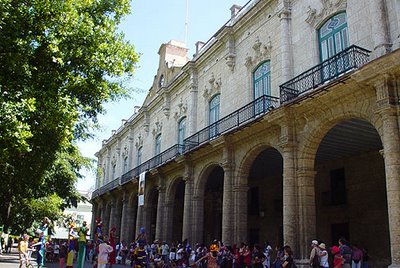 This from www.faithfuldeliveries.com - a nice web site, with photos of today's Cuba, whose beauty shines through as witnessed by the photographs displayed, despite the unkindness of the past 47 years, under the misrule of the "captain-general" from Hell. Today, the building is a museum.
This from www.faithfuldeliveries.com - a nice web site, with photos of today's Cuba, whose beauty shines through as witnessed by the photographs displayed, despite the unkindness of the past 47 years, under the misrule of the "captain-general" from Hell. Today, the building is a museum.Next stop - Avenida de las Palmas - "Avenue of the Palms;" Palm Avenue, if you prefer. No, that appellation has been co-opted by the city of Hialeah, Florida. And no doubt by many other cities and towns all over the world. We'll settle for the more poetic "Avenida de las Palmas."
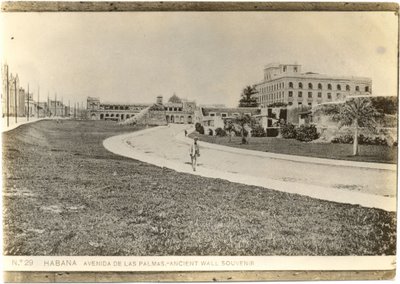
Hate to tell you, but according to the annotation to the photograph, the name was subsequently changed to Avenida de las Misiones, that is, "Avenue of the Missions." It is our mission to inform you of that...must not get lost and run into trouble, because according to our good tour guide, the 3rd Precinct Police station was situated here. Sorry, do not know which of the buildings is the police station one. Perhaps it was not even built at the time the photograph was made - we don't want to find out anyway, right? Stay out of trouble, stay far away from police stations. Unfortunately, that is something today's Habaneros do not have the luxury to avoid. There is a constant police presence, and they are decidedly not friendly types.
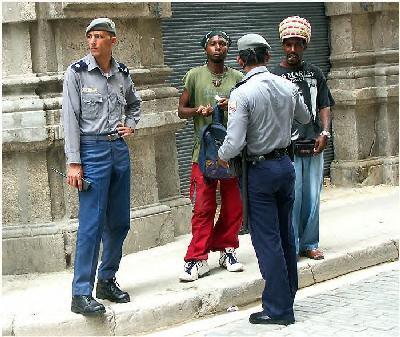 Do these present-day policias Habaneros seem friendly? Nein!
Do these present-day policias Habaneros seem friendly? Nein!The "captain-general" from Hell does not want them - or himself - to be friendly. Freundschaft ist verboten! Friendship is forbidden. Fortunately, neither our Time Travelers nor their tour guide have to worry about that in early 1900's Havana.
(www.therealcuba.com)
Here are some friendlier views of Avenida de las Misiones, from Julius Nicolai Von Schmidt's website. The year is 1947.
 Surely, our Time Travelers by now recognize Morro Castle in the background.
Surely, our Time Travelers by now recognize Morro Castle in the background.The view below includes the Presidential Palace, Palacio Presidencial. Needs no translation, I suppose. Another landmark for our Time Tourists.
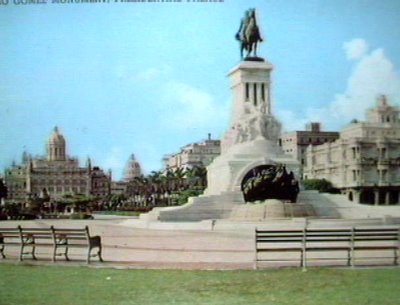
Perchance, if our Time Travelers had committed some infraction, after being detained at the 3rd Precinct Police station, they might have been required to take involuntary lodgings at the "Carcel y Presidio." Jail and Prison - seen here...
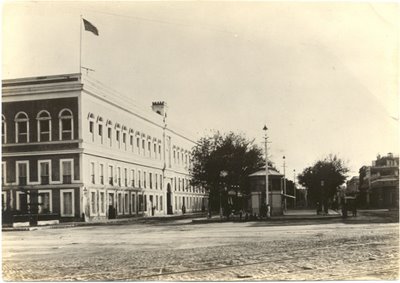
Our indefatigable Mr. Peralta's annotation includes this tidbit - "derecho: Cafe El Tiburon." The Shark Cafe - right across the street from the jail. How convenient, and how well named! Is this where the lawyers hung out? Just kidding! Unfortunately, these legal niceties remind one of a certain "lawyer" who years later would make himself the law of the land - misusing the law for totalitarian ends. The captain general from Hell transforming himself into the lawyer - no, shyster, from Hades. We'll see how good a defense he can concoct comes his time to face the Maximum Judge.
Speaking of jails, courtrooms, judges and such brings to mind a popular radio spoof about matters legal, which a young blogger-to-be enjoyed in those days - I don't mean 1902, now! We've now time-warped through the airwaves and the dial in our Time Travelers' DeLorean's radio is set to around 1956...and we happen to hit on a particular station, RHC Radio "Cadena Azul;" literally, the Blue Chain, simbolizing the chain of stations in that network. The program in question was - and in fact, amazingly, is still around, though not heard through Cuba's present-day airwaves - "La Tremenda Corte." An exact, but not quite capture-the-zaniness of the production translation would be "The Tremendous Courtroom." But you get a better idea what it was all about if we call it "Incredible Court," or "Incredible Courtroom." The players were the judge, Anibal de Mar, whose stage or radio moniker was "Filomeno," the defendant, Leopoldo Fernandez, known by listeners as "Trespatines," or "3-Skates," and Mimi Cal, or "Nananina," who at one time had been married to Mr. Fernandez. And sometimes, since they continued doing shows after their divorce, the little barbs and exchanges between them, shall we say, were more pointed than usual. There was a fourth character who typified the stereotype of the Spaniard from Galicia, of which there were many in Havana, indeed, all Cuba - known as Rudesindo Caldeiro y Escobinas - tilde over the "n."
And, by the way, many if not most in my father's and mother's side hail from Galicia. But we never took offense when Rudesindo portrayed a simple, somewhat dim-witted Gallego over the airwaves. Come to think about it, don't remember anybody who did. Back then, people seemed to have a sense of humor. Habaneros definitely did, and everyone knew the characters portrayed were fictional and meant to bring joy through laughter. Today, some self-appointed "activist" group promoting some laughable pseudo-grievance extracted from the loony bin would undoubtedly protest the characters exemplified by Rudesindo, Trespatines, The Judge, and Nananina. To which, Trespatines would say, I believe, if he were around, "Get a life, stop global whining, and if ya don't like it, turn da radio off or shove it where da sun don' shine!" Apologize for being unable to accurately translate this into PCS - Proper Cuban Spanish. Fooled ya - bet you thought that stood for Politically Correct Spanish. Que va, Jose! Or as Trespatines would say, "que cosa mas grande!"
The usual show involved some antic or shenanigan perpetrated by Trespatines, which would invariably land him in the courtroom as the sole defendant, usually accused by "Nananina" or Rudesindo of some violation, breach of contract, or some such thing. The production was characterized by a lot of verbal slapstick, puns, innuendos, plays on words, and other tricks of the humor trade which even a young kid learned to appreciate and laugh over. One memorable exchange between the judge and "Trespatines, which still brings a chuckle to a kid-at-heart, is recalled as follows - it is not an exact transcript, as it comes from the memory-bank of an older, not necessarily wiser, brain:
Trespatines: "Did you know, my mamita (diminutive for mother - Trespatines would bring up his "mamita" frequently and weave some tale involving HER antics) just died?"
Judge: "No! I had no idea - what happened? Did she die a natural death?"
Trespatines: "Well, she died a natural death. She was run over by a train."
Judge (sounding exasperated): "But, Trespatines - how could she possibly die a natural death if she was run over by a train?!"
Trespatines: "Well, your Honor, it is perfectly natural one should die if run over by a train!"
Invariably, at the conclusion of the show, Trespatines would always be convicted of whatever transgression he had committed, and get slapped with jail, or fines, or both. The judge would creatively render the sentence in rhyme.
And here is our cast of characters from "La Tremenda Corte;" unfortunately, all gone now, but hopefully to bigger and better Broadcast Facilities, no doubt still entertaining - surely God has an infinite sense of humor...
 (www.cubaliberal.org)
(www.cubaliberal.org)Left: Leopoldo Fernandez (in blackface); top center, Mimi Cal with Anibal de Mar below; right; Anibal de Mar in his "judgmental" pose.
If you would like to listen to the original broadcasts, in Spanish, of course -Cuban Spanish - technically speaking - tune in here
There are over 100 episodes for your listening pleasure.
Let's close with a musical interlude, a song version of one of the courtroom encounters between El Juez (The Judge) and Tres Patines -
We shall continue our regularly scheduled program in due course. The Time Travelers shall continue their journey meantime. Hopefully, they will not run out of gas. If they do, they can park in some nice, shady Habana street, tune in to RHC Cadena Azul, and listen to La Tremenda Corte while sippin' some fine Bacardi rum.
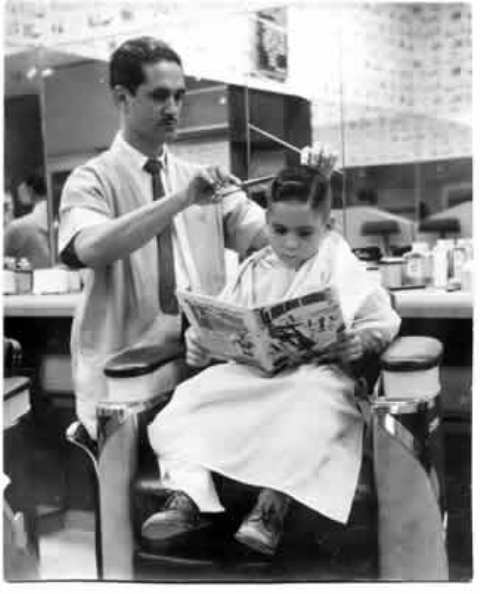
2 Comments:
The compliments from all are greatly appreciated - thank you!
Alberto thank you very much, my dad has wanted to hear Pototo y Filomeno for the longuest time. Thanks, this is wonderful!!!
Post a Comment
<< Home